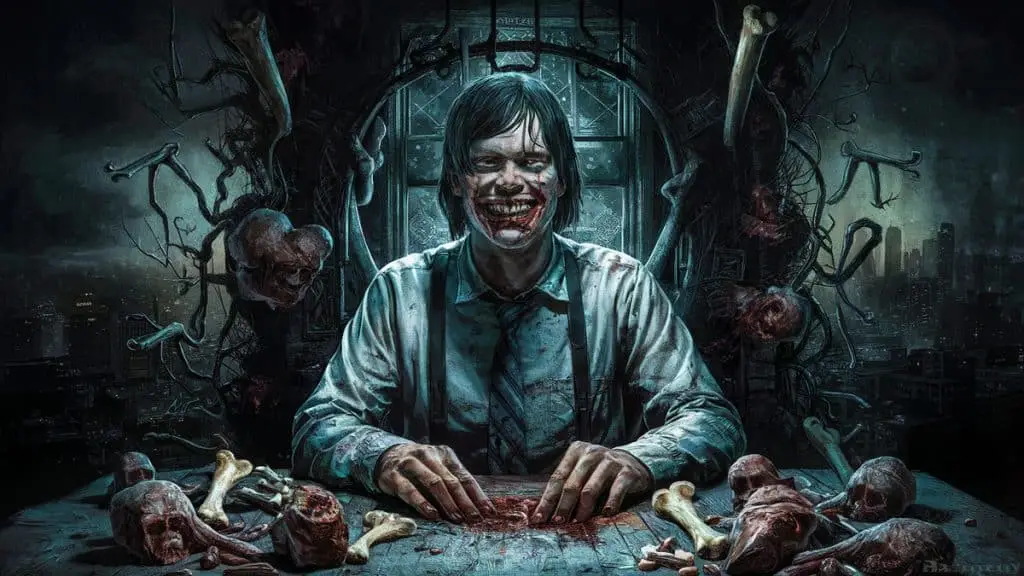The Milwaukee Cannibal: Unraveling the Chilling Tale of Jeffrey Dahmer. Jeffrey Dahmer, also known as the Milwaukee Cannibal, is a name that stands out in American criminal history. His crimes throughout the late 20th century shocked the nation and brought to light the gruesome nature of his offenses. Dahmer was responsible for the murder and dismemberment of seventeen young men between 1978 and 1991, with his actions casting a long and somber shadow over the city of Milwaukee.

Dahmer’s methodology was particularly chilling, often luring his victims with promises of money or company before committing his crimes. His notoriety escalated when it was discovered that his crimes went beyond murder; they included acts of cannibalism and preservation of body parts, which led to his unsettling moniker.
While Dahmer’s life ended in 1994 at the hands of a fellow prison inmate, the legacy of his actions continues to be examined. The case raised numerous questions about the nature of criminal psychology, the effectiveness of law enforcement, and the means by which society can prevent such tragic events from occurring again. Through this examination, it is hoped that understanding the depths of such behavior can lead to better preventative measures in the future.
Early Life and Background

Jeffrey Dahmer, also known as the Milwaukee Cannibal, was born into an average family, yet he experienced an atypical upbringing that shaped his troubled future. His life both at home and in school was marked with unusual behavior and unsettling incidents.
Family and Childhood
Jeffrey Dahmer was born on May 21, 1960, in Milwaukee, Wisconsin. His father, Lionel Dahmer, was a chemist, which may have exposed Jeffrey early on to the scientific concepts he later twisted for his crimes. The family moved to Bath Township, Ohio, where Jeffrey spent most of his childhood in a seemingly normal suburban neighborhood.
- Parents: Lionel and Joyce Dahmer
- Siblings: One younger brother
- Residences: Milwaukee, Wisconsin; Bath Township, Ohio
- Early Interests: Collecting animal bones, exploring animal anatomy
During his early years, Dahmer displayed a disturbing fascination with dead animals, a fact later reported by his father. This behavior was a sign of his troubling inner world that went largely unnoticed or was dismissed as childlike curiosity.
High School and Army Stint
In high school, Dahmer was an introverted student, displaying little interest in social or extracurricular activities. He attended Revere High School in Ohio, where his isolation and alcohol abuse began to surface.
After graduation, Dahmer briefly attended college before enrolling in the Army. His time in the service took him to Germany, but he was later discharged due to his alcoholism, which continued to escalate and contribute to his volatile behavior.
- High School: Revere High School in Ohio
- Military Service: U.S. Army
- Posted In: Germany
- Challenges: Alcoholism, Discharge due to alcohol abuse
Dahmer’s early life was a complex tapestry of mundane family settings shadowed by his unsettling behavior, a combination that foreshadowed his future actions.
Timeline of Crimes
https://www.youtube.com/watch?v=fgLF84_Q3J8&embed=true
Jeffrey Dahmer’s criminal activities spanned from his first murder in 1978 to his final capture in 1991. This timeline delves into the key moments of his nefarious acts, focusing on the beginning, middle, and end of his crimes.
First Murder
- 1978: Jeffrey Dahmer committed his first murder at the age of 18, shortly after his high school graduation. He picked up a hitchhiker named Steven Hicks and lured him to his parents’ house in Ohio. It was here that Dahmer bludgeoned and strangled Hicks before dismembering his body.
Arrest and Confession
- July 22, 1991: Dahmer was arrested after Tracy Edwards, a potential victim, escaped and flagged down two police officers. Edwards led them back to Dahmer’s apartment, where they found Polaroid photos of dismembered victims. This discovery prompted a thorough search, unveiling more incriminating evidence.
- Following his arrest, Dahmer confessed to 17 murders, providing detailed accounts of his horrific acts that included not just killing but also necrophilia and cannibalism. The evidence and confession brought Dahmer’s sinister activities into the public eye.
Final Capture
- 1991: The police, after being alerted by Edwards, eventually seized Dahmer at his Milwaukee apartment, marking the end of a series of gruesome crimes. At his apartment, authorities discovered human remains and learned about Dahmer’s macabre interests. His capture brought relief to a terrified community, and he was charged with multiple counts of murder.
Modus Operandi
https://www.youtube.com/watch?v=6Z_dYdArh4A&embed=true
Jeffrey Dahmer, known as the Milwaukee Cannibal, had a distinct pattern of behavior when it came to his crimes. His modus operandi involved a combination of drugging his victims to control them, engaging in acts of necrophilia and cannibalism, and keeping certain body parts as trophies.
Victim Profile
Dahmer targeted males predominantly in their late teens and early twenties. He often sought victims in places like bars and malls, luring them with offers of money for their company or to pose for photographs. Once they were in his control, he subjected them to his macabre rituals.
Killing and Dismemberment Techniques
After gaining control of his victims through drugs, Dahmer would proceed to kill them, typically by strangulation. Post-mortem, he dismembered their bodies with methodical precision, often keeping skulls and other body parts as mementos. Reports indicate that Dahmer engaged in both cannibalism and necrophilia with his victims.
Psychological Aspect
The acts of cannibalism and necrophilia stemmed from Dahmer’s deep psychological need to possess his victims completely. By consuming their flesh and engaging in sexual acts with their bodies, he sought a twisted form of closeness and control even after their death.
Trial and Incarceration
https://www.youtube.com/watch?v=anQUU0YakMg&embed=true
Jeffrey Dahmer, known as the Milwaukee Cannibal, faced justice for his heinous crimes during a highly publicized trial. His incarceration brought a chilling chapter in criminal history to a close, marked by his interaction with fellow inmates and a violent end within the penitentiary.
Court Proceedings
In January 1992, Jeffrey Dahmer’s court proceedings began. He pleaded guilty but insane to 15 counts of murder. Despite his plea, the jury found Dahmer to be legally sane during his murder spree, and hence fully responsible for his actions. Dahmer’s sentence amounted to 15 consecutive life terms, making parole a virtual impossibility, and translating to a cumulative sentence of over 900 years behind bars.
Life in Prison
Dahmer served his time at the Columbia Correctional Institution in Portage, Wisconsin. Within prison walls, he reportedly found religion, but remained a target for violence due to the nature of his crimes. In a fateful turn on November 28, 1994, Dahmer and another inmate named Jesse Anderson were bludgeoned by Christopher Scarver, a fellow inmate, with a metal bar from the prison weight room. Dahmer succumbed to his injuries and was pronounced dead, concluding his life and incarceration.
Cultural and Societal Impact
https://www.youtube.com/watch?v=Y1EWmrzD2Mk&embed=true
The case of the Milwaukee Cannibal has resonated deeply within society, influencing media coverage and pop culture in various ways.
Media Coverage
The press extensively covered the grisly details of the crimes committed by the Milwaukee Cannibal. Notably, on November 28, 1994, the news of his death was widely reported, stirring a wave of public and media reaction. This coverage included everything from straightforward news reporting to more sensational stories on programs such as “Inside Edition.” The media’s focus on the story brought global attention to the case and increased public discourse on issues of criminal psychology and the justice system.
Influence on Pop Culture
The chilling story has permeated pop culture, inspiring a range of books and fictionalized adaptations. Stories derived from the events surrounding the Milwaukee Cannibal can be seen in television, film, and literature, often blurring the line between fact and fiction. His influence on the horror genre is significant, with numerous works exploring the dark themes associated with his crimes. These portrayals contribute to a broader societal fascination with true crime and the psychology of serial killers.
Steve is the creative force behind My Unique Tales, a blog dedicated to sharing captivating stories that explore the human experience in all its complexity. With a passion for writing and a talent for crafting engaging narratives, Steve's blog is a treasure trove of imaginative tales that transport readers to other worlds and challenge them to see things from new perspectives. From epic adventures to intimate character studies, Steve's stories are always thought-provoking and emotionally resonant. With a growing following of readers who appreciate his unique voice and creative vision, Steve is quickly becoming a rising star in the world of online storytelling.






